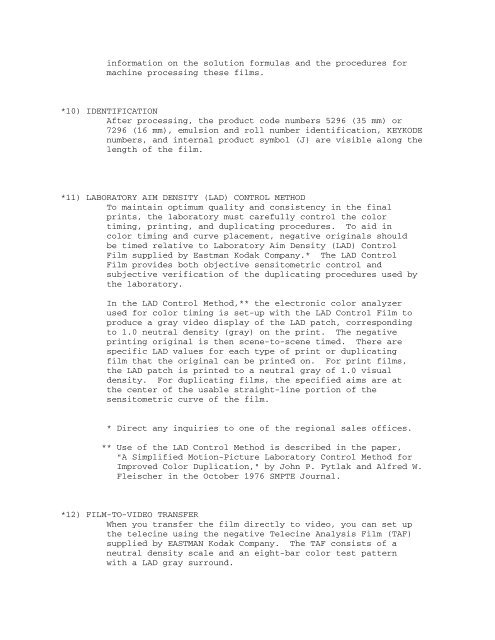eastman 500t 5296 exr - Kodak
eastman 500t 5296 exr - Kodak
eastman 500t 5296 exr - Kodak
You also want an ePaper? Increase the reach of your titles
YUMPU automatically turns print PDFs into web optimized ePapers that Google loves.
information on the solution formulas and the procedures for<br />
machine processing these films.<br />
*10) IDENTIFICATION<br />
After processing, the product code numbers <strong>5296</strong> (35 mm) or<br />
7296 (16 mm), emulsion and roll number identification, KEYKODE<br />
numbers, and internal product symbol (J) are visible along the<br />
length of the film.<br />
*11) LABORATORY AIM DENSITY (LAD) CONTROL METHOD<br />
To maintain optimum quality and consistency in the final<br />
prints, the laboratory must carefully control the color<br />
timing, printing, and duplicating procedures. To aid in<br />
color timing and curve placement, negative originals should<br />
be timed relative to Laboratory Aim Density (LAD) Control<br />
Film supplied by Eastman <strong>Kodak</strong> Company.* The LAD Control<br />
Film provides both objective sensitometric control and<br />
subjective verification of the duplicating procedures used by<br />
the laboratory.<br />
In the LAD Control Method,** the electronic color analyzer<br />
used for color timing is set-up with the LAD Control Film to<br />
produce a gray video display of the LAD patch, corresponding<br />
to 1.0 neutral density (gray) on the print. The negative<br />
printing original is then scene-to-scene timed. There are<br />
specific LAD values for each type of print or duplicating<br />
film that the original can be printed on. For print films,<br />
the LAD patch is printed to a neutral gray of 1.0 visual<br />
density. For duplicating films, the specified aims are at<br />
the center of the usable straight-line portion of the<br />
sensitometric curve of the film.<br />
* Direct any inquiries to one of the regional sales offices.<br />
** Use of the LAD Control Method is described in the paper,<br />
"A Simplified Motion-Picture Laboratory Control Method for<br />
Improved Color Duplication," by John P. Pytlak and Alfred W.<br />
Fleischer in the October 1976 SMPTE Journal.<br />
*12) FILM-TO-VIDEO TRANSFER<br />
When you transfer the film directly to video, you can set up<br />
the telecine using the negative Telecine Analysis Film (TAF)<br />
supplied by EASTMAN <strong>Kodak</strong> Company. The TAF consists of a<br />
neutral density scale and an eight-bar color test pattern<br />
with a LAD gray surround.

















